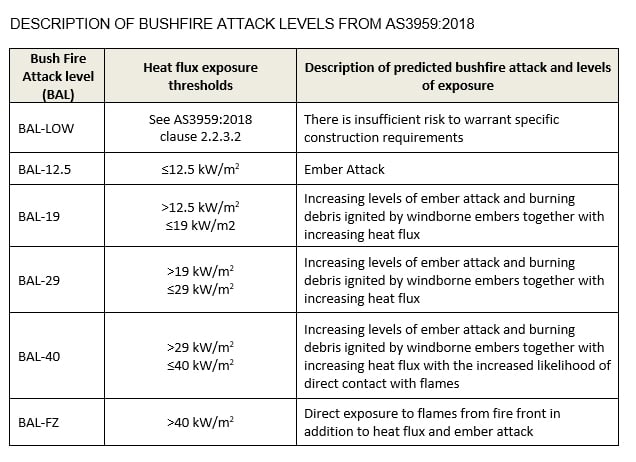More than 3,000 properties were destroyed in the 2019-2020 bushfire season, and 33 people have lost their lives. Unfortunately, BOM has just declared an El Niño climate pattern for the 2023-2024 summer period, increasing the chances of another hot and dry season and the heightened risk of dangerous bushfires.
This blog looks at some of the strategies that can be employed to make houses more fire resilient.
Apart from the emotional turmoil of losing a home, a property is usually our most important investment.
While there will never be a guarantee that your house will survive a blaze under severe circumstances, there are certain strategies you can follow to improve the odds.
Please note: The State Rural Fire Service and other emergency services put out regular communication regarding fire updates during bushfire incidents and should be seen as the first point of information under all circumstances. Strategies to fire-proof a property may minimise the damage, but we do not advise using the home as shelter when emergency services indicate that leaving the area is advisable. The safest option is always to leave early!
Fire resistance starts with design
To give a building a fighting chance of surviving a bushfire, fire resistant strategies need to be implemented from the design stage. Architects and bushfire experts agree that it is time to rethink how we design buildings in bushfire prone areas.
“Australians need to (re)think beyond the paradigm of the timber hideaway in the bush and realise that being able to inhabit such sites is an extraordinary privilege - and with that privilege comes the onus of building bushfire resilient homes - rather than modifying that landscape to suit their preconceived and outdated ideas,” said Dr. Ian Weir, a researcher at Queensland University of Technology who studies bushfire responsive architecture.
The Australian Institute of Architects established a dedicated bushfire response website where a number of its Acumen practice notes relating to post-fire design is freely available.
“This is not a short-term crisis, and we need the support of the architectural profession to support us as we face this crisis together. When the fires clear, we will need to not only replace what has been lost, but build back better,” the Institute stated on the website during the 2019-2020 bushfire crisis.
Passive house design
Passive house design is gaining popularity in Australia due to its focus on sustainability and energy efficiency.
It relies on the adoption of a few key design principles to enable the creation of energy efficient buildings with healthy, dry indoor spaces that require little or no heating or cooling. Read more about it in our blog The 5 principles of passive house design.
A big win of this design trend is that many of the strategies employed in this type of sustainable construction can also help to make a property more fire resilient. This includes the use of triple-glazed windows and an airtight building envelope, which for instance prevents toxic gases and smoke from entering the building.
Siniat supplied plasterboard to Sapphire House, Australia’s first passive house built to the highest bushfire rating (BAL-FZ). Read more about bushfire ratings (BAL) below.
Standards and codes
Over the last 25 years Australian building codes and standards have become considerably more comprehensive to include strategies to make buildings more fire resilient.
The codes include performance standards and appropriate materials to resist bushfire attack.
The current standards related to bushfire issues are:
- AS 3959:2018 Construction of buildings in bushfire-prone areas
- AS 5414 – 2012 Bushfire water spray systems
- ABCB, Private Bushfire Shelters Performance Standard 2014
- NASH Standard Steel Framed Construction in Bushfire Areas 2014
National building requirements for residences in bushfire prone areas were improved after the 2009 “Black Saturday” bushfires in Victoria, in which 173 people died and more than 2,000 homes were destroyed.
According to an article in published on The Conversation in January 2020, more can possible be done to make homes more fireproof, but that doesn’t necessarily mean Australia’s building regulations need reforming to ensure homes are made more fireproof.
Bushfire Attack Level (BAL)
In addition to the provisions of the BCA, the Australian Standard for Building in Bushfire Prone Areas (AS3959) provides further requirements for residential dwellings built in areas that pose a high risk of bushfires.
The AS3959 divides bushfire prone areas into six bushfire attack levels (BAL), based on the severity of the building’s potential exposure to ember attack, radiant heat and direct flame contact in the event of an uncontrolled bushfire. BAL ratings are measured in increments of radiant heat expressed as kW/m2.
The most severe bushfire attack level is described in the standard as BAL-FZ and is primarily concerned with protection from flame contact together with ember attack and radiant heat of more than 40 kW/m2.
All new residential homes built in a bushfire prone area must undergo a BAL assessment as part of the application for a building permit.
The six BALs are:
- BAL-LOW - very low risk
- BAL-12.5 - low risk
- BAL-19 - moderate risk
- BAL-29 - high risk
- BAL-40 - very high risk
- BAL-FZ - extreme risk (Flame Zone)

AS 3959 explains how the BAL for a property is determined and provides the construction requirements for each level of BAL, including for floors, roofs, external walls and windows, verandahs and carports.
All new homes built in a Bushfire Prone Areas must be built to a minimum of BAL- 12.5.
BALs may change due to environmental factors, such as when nearby cleared areas become forested.
At Siniat we therefore recommend always building to BAL-FZ requirements because any solution that satisfies the requirements of BAL-FZ will also work for a lower BAL.
Also read A guide to accessing your property’s Bushfire Attack Level (BAL).
Existing buildings
While codes, standards and improved design strategies can go a long way to improve the fire resilience of new structures, it remains extremely difficult to protect older structures.
The NSW Rural Fire Service provides a few basic maintenance tips to prepare a property for a bushfire, including cleaning gutters of twigs and leaves, attaching a fire sprinkler system to the gutters and cutting back trees and shrubs overhanging the buildings.
Also refer to bushfire architect Dr. Douglas Brown’s blog, 12 simple ways you can reduce bushfire risk to older homes.
For more information on Siniat’s fire resistant and BAL compliant solutions, contact our technical services team on 1 300 724 505.







